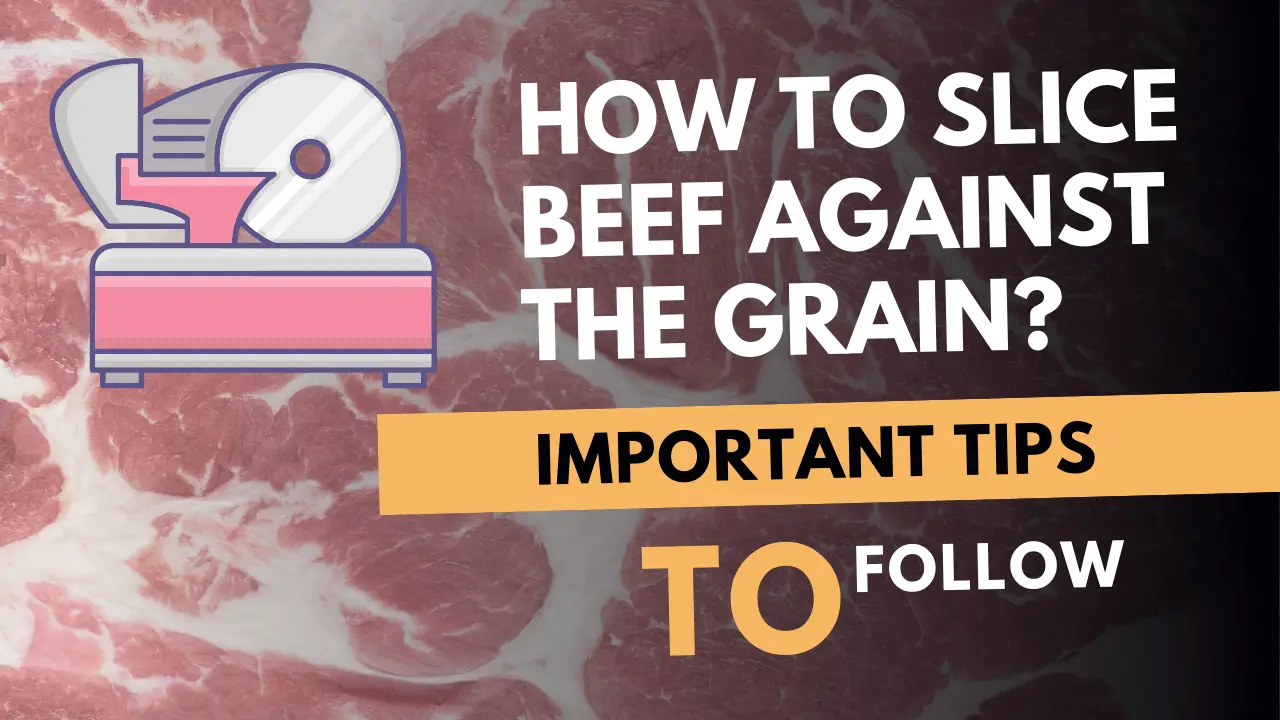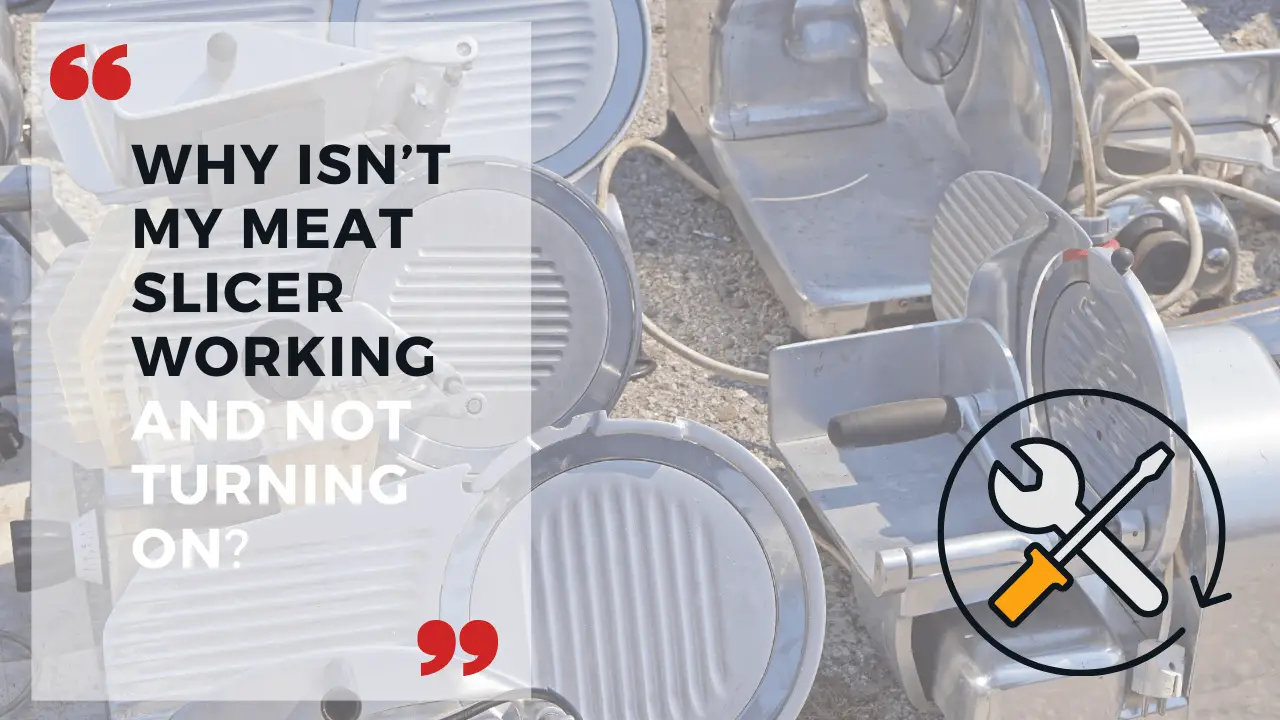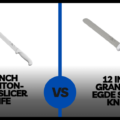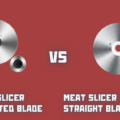A meat grinder may sound like an intimidating kitchen tool, but it’s quite easy to use. It is also a valuable and versatile addition to any kitchen. With a meat grinder, you can grind your own fresh meats for burgers, sausages, tacos, and more. Not only that, but you can also grind vegetables, dried fruits, and nuts for sauces and flavorful dishes.
What Is A Meat Grinder?
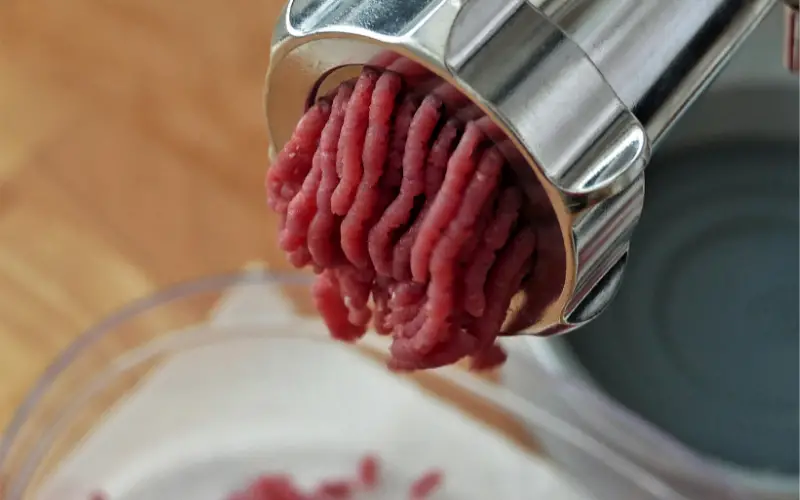
A meat grinder is a kitchen appliance used to mince, grind, or pulverize different types of meat into small pieces. It typically consists of a hopper that holds the uncut meat, sharp blades which rotate when powered by an electric motor, and usually comes with different size plates for coarse to fine grinding. Some grinders also have a sausage-stuffing attachment, enabling you to make your own homemade sausages.
For home cooks, meat grinders offer an efficient and convenient way to process their own meat instead of buying pre-ground products from the store, which are usually less healthy since they contain added preservatives or fillers. Grinders also provide the ability to control the size and texture of the minced meat, allowing for a greater degree of customization.
Types Of Meat Grinders
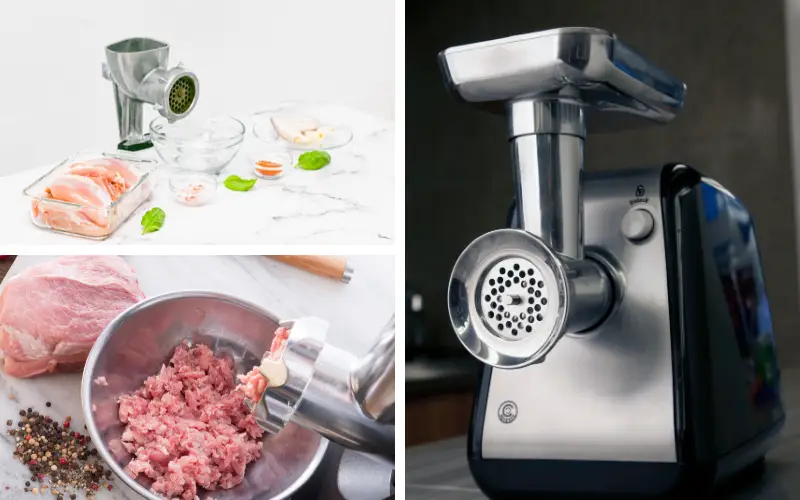
There are several types of meat grinders, each with its own unique features and benefits.
- Manual: Manual meat grinders are hand-operated, typically with a crank. They’re affordable and portable, making them a popular choice for those on a budget or with limited kitchen space. However, they require more physical effort and time to use.
- Electric: Electric meat grinders are powered by a motor and can process meat quickly and efficiently. They come in various sizes and power levels, making them suitable for home and commercial use. However, they are more expensive and occupy more space than manual grinders.
- Attachment: Meat grinder attachments are designed to connect to other kitchen appliances, such as stand mixers. This option allows you to save space and money by utilizing a device you own.
How Does A Meat Grinder Work?
A meat grinder processes meat by pushing it through a grinding plate with small holes, creating a consistent texture. The holes’ size determines the grind’s coarseness, and most grinders come with multiple plates to accommodate different preferences.
Parts Of Meat Slicer
- Feeding Tube: This is the large tube into which meat, vegetables, and other items are placed before grinding. It can be easily detached from the grinder for cleaning purposes.
- Screw Ring: The screw ring is a circular piece of metal placed over the meat grinder’s feed tube. It helps to keep the feed tube in place and keeps it from moving around while you grind your meat.
- Extruder: An extruder is a device used to grind, shape, or mix ground meat. This machine uses an interchangeable die and screw for various product thicknesses. It can also produce sausages, burgers, and other shaped products.
- Cutting Blade: Commonly known as the cutting knife, this is the most important part of a meat grinder and does all the work. It is responsible for grinding down the tough cuts of meat into smaller pieces to make them easier to cook. It is typically made of stainless steel and should be sharpened regularly for the best results.
- Sausage Stuffer: A sausage stuffer is a small device that helps you quickly fill either natural or artificial casings with your choice of ground meat. This makes creating sausage at home much easier and more efficient. Most staffers come in one- or two-pound capacity models, with a hand crank, electric motor, and vacuum versions available. They can be used with any ground meat, allowing you to make delicious links with beef, pork, chicken, or even fish.
- Meat Tray: A meat grinder typically comes with a tray or holder that functions as the surface to hold your cut of meat. Some grinders come with an adjustable tray, allowing you to adjust how wide it is and fit different sizes of cuts of meat. The tray collects the ground meat after it has been processed by the grinder, making it easy to transfer it to other containers or pans.
- Meat Pusher: A meat pusher is an accessory that goes along with a meat grinder. A large metal rod usually helps push the meat pieces into the grinder’s feed tube. The more pressure you apply, the faster and more efficiently your grinder can process the food. This will result in finely ground pieces of meat. Using the right size and shape pusher for your specific grinder is important, as using one that is too small or large can cause jamming in the machine.
- Motor: A meat grinder requires electricity, and many models have a powerful motor. The motor’s power determines how quickly and efficiently you grind your meat. Look for motors with a high wattage or horsepower rating to ensure you get the best performance out of your grinder.
- Grinder Plate: The grinder plate is part of the meat grinder that holds the blades. It comes in various sizes and shapes, depending on your grinder type, such as those with two or three plates for various grinding needs.
Advantages Of Owning A Meat Grinder
Owning a meat grinder offers several benefits, including:
- Cost savings: Buying whole cuts of meat and grinding them yourself can save money.
- Quality control: Grinding your own meat allows you to control the freshness and quality.
- Healthier options: Grinding your own meat reduces the risk of consuming additives and preservatives in pre-packaged ground meat.
- Improved texture and flavor: Freshly ground meat tends to have a better texture and taste than pre-ground meat.
Choosing The Right Meat Grinder
To select the perfect meat grinder for your needs, consider the following factors:
- Grinder Size: Meat grinders are classified by their size, which is determined by the diameter of the grinding plate. The size typically ranges from 5 to 32, with larger numbers indicating larger grinders. Choose a size based on the amount of meat you plan to process and the available space in your kitchen.
- Materials: Meat grinders can be made from various materials, including plastic, aluminum, and stainless steel. Consider durability, weight, and ease of cleaning when evaluating materials.
- Motor Power: Electric meat grinders have motors with varying power levels, measured in watts or horsepower. A higher power rating generally means the grinder can process more meat in less time. Consider your grinding frequency and volume when selecting a motor power.
- Features and Attachments: Some meat grinders include additional features and attachments, such as sausage stuffers or pasta makers. Consider your culinary needs and preferences when evaluating these options.
How To Use A Meat Grinder?
Using a meat grinder is a simple process:
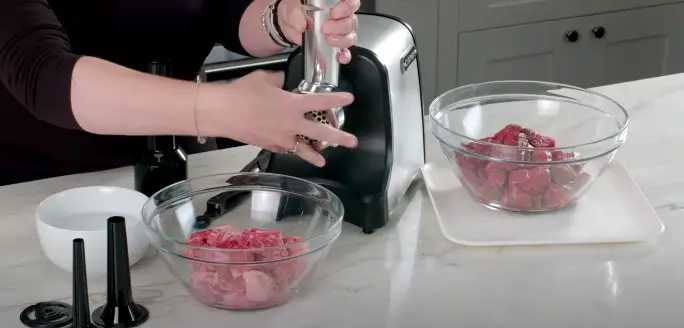
Step 1: Assemble the grinder according to the manufacturer’s instructions.
Step 2: Cut the meat into small pieces that fit easily into the grinder’s feeding tube.
Step 3: Choose the appropriate grinding plate for your desired coarseness.
Step 4: Turn on the grinder (or start cranking if using a manual grinder).
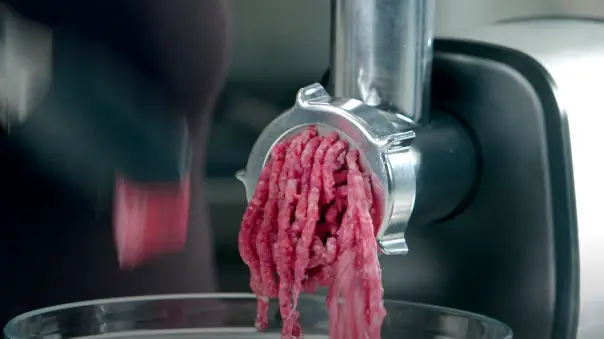
Step 5: Feed the meat into the grinder, gently pushing it down the tube with a stomper or your hand.
Maintenance And Cleaning
To ensure your meat grinder stays in optimal condition, follow these maintenance and cleaning tips:
- Disassemble the grinder after each use.
- Wash all parts thoroughly with warm, soapy water.
- Dry all components completely to prevent rust and corrosion.
- Lubricate moving parts according to the manufacturer’s recommendations.
- Store the grinder in a cool, dry place when not in use.
Meat Grinder Safety Tips
To use your meat grinder safely, remember these guidelines:
- Always unplug electric grinders or detach manual grinders from power sources before cleaning.
- Use the provided stomper to push the meat into the grinder, never your hands.
- Keep fingers and long hair away from moving parts.
- Do not attempt to grind bones, as this can damage the grinder.
- Follow the manufacturer’s instructions for proper use and maintenance.
Difference Between A Food Processor And A Meat Grinder
- Size: Meat grinders are larger than food processors because they have a motor that needs more space and makes heavier duties. Food processors are smaller and simpler appliances used for chopping vegetables or fruits, pureeing soups, kneading dough, etc.
- Design: Meat grinders are usually designed with heavy-duty metal or plastic housing. The bowl is separate and attached to the main unit, while the feed tube, grinding blades, and plate are above it. On the other hand, food processors generally have one bowl that can be locked shut with a lid and several blades and discs for different tasks.
- Use: Meat grinders are mainly used to mince or grind meats, such as beef, chicken, pork, and fish. However, some models can make sausages, burgers, or vegetables like potatoes and onions. Food processors are more versatile; they can be used to chop, grind, grate, and puree ingredients.
- Price: Meat grinders are more expensive than food processors as they have a motor that requires more power and is usually better quality. Food processors tend to be cheaper due to their simplicity and smaller size.
FAQs
Is it a good idea to freeze meat before grinding it?
It is possible to grind pre-frozen meat, but it depends on your grinder type. If you’re using a manual or electric grinder, it’s best not to freeze the meat beforehand since frozen chunks can damage the blades and be difficult to process. However, some advanced commercial-grade grinders are designed to handle frozen chunks of meat, making grinding easier and more efficient.
Which meat grinder is better, manual or electric?
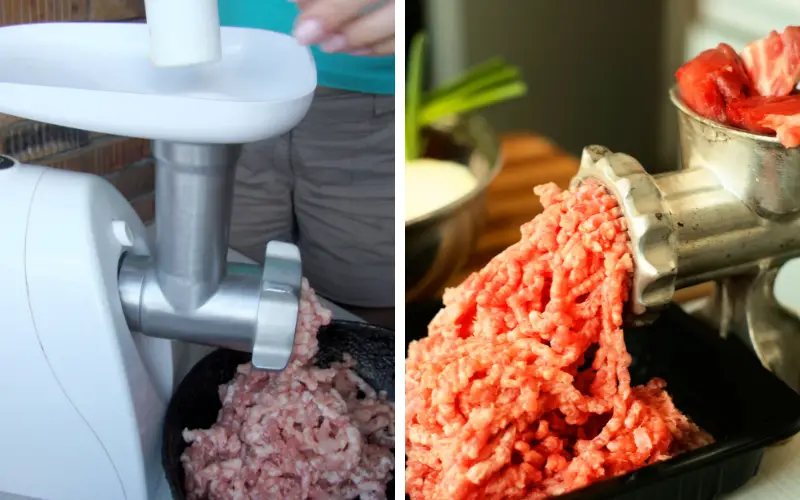
It ultimately depends on your needs when deciding which meat grinder is better, manual or electric. Manual meat grinders are smaller and more portable than electric ones, making them great for home use. They often don’t have the same power as electric grinders but can still do a good job grinding tougher meat cuts. On the other hand, electric grinders are more powerful and can handle a larger volume of food at once. They are ideal for commercial use but may be overkill if you want a homemade grinder. A manual grinder might be better if you have limited counter space or want something easy to store away when not in use.
How long does a meat slicer long?
The life expectancy of a meat grinder is largely determined by the quality of materials used in its construction and the frequency with which it is used. Generally, high-quality commercial-grade grinders are designed to last many years, while lower-quality models may require more frequent maintenance or sooner replacement. If you take proper care of your grinder and use it appropriately, a properly-made grinder should last you for years.
Conclusion
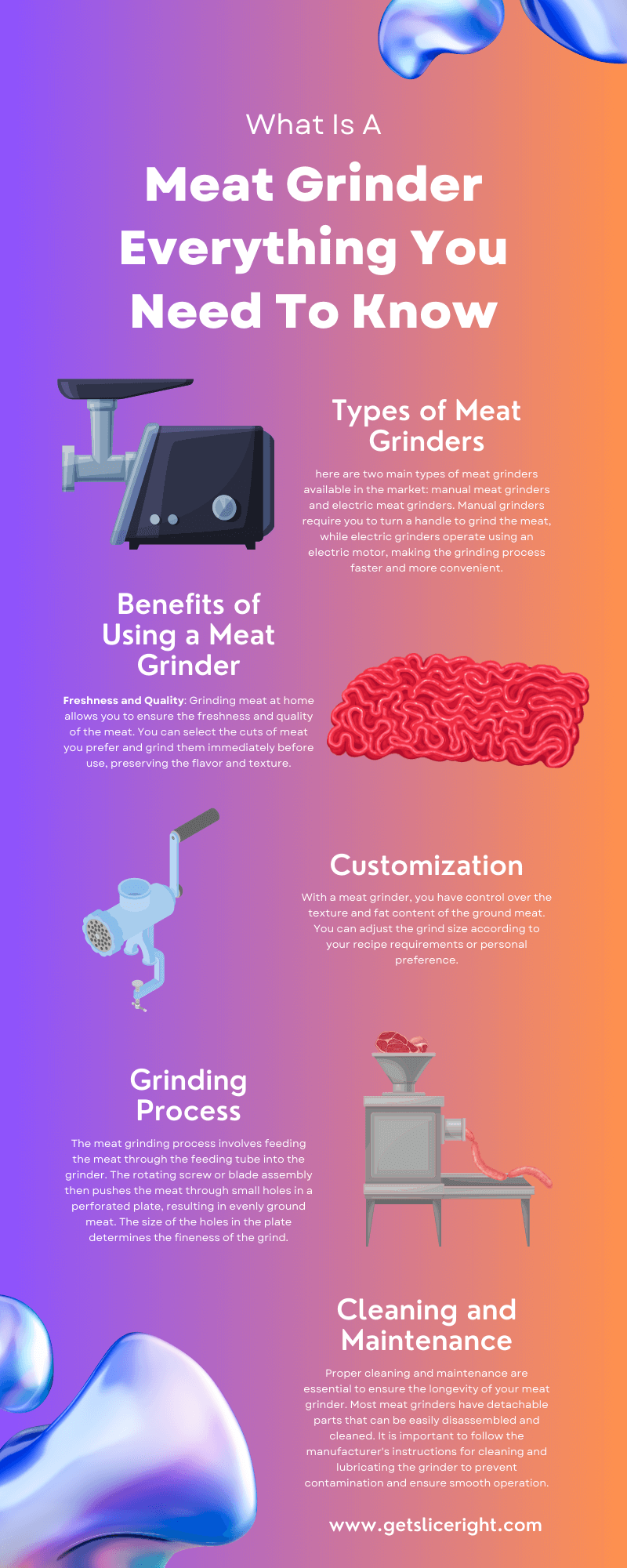
A meat grinder is a versatile and valuable addition to any kitchen. By understanding the different types, features, and uses of meat grinders, you can make an informed decision and enjoy the benefits of grinding your own meat.

Mario Batali is a renowned author, food enthusiast, and passionate chef who has dedicated his life to exploring the world of culinary arts. With a love for sharing his knowledge and experiences, Mario has become a prominent figure in the food blogging community, inspiring countless readers with his creativity and expertise.
In addition to his culinary prowess, Mario Batali is also a talented writer with a flair for engaging storytelling. He launched his own food blog to share his recipes, cooking tips, and personal experiences in the kitchen. Over time, Mario’s blog gained a loyal following of food enthusiasts who appreciate his unique approach to cooking and his dedication to using only the finest ingredients.
Mario Batali’s passion for food and his commitment to sharing his knowledge with others have made him a true inspiration in the world of culinary arts. Through his blog, cookbooks, and public appearances, Mario continues to spread his love of food and the joy of cooking with his ever-growing fanbase.

